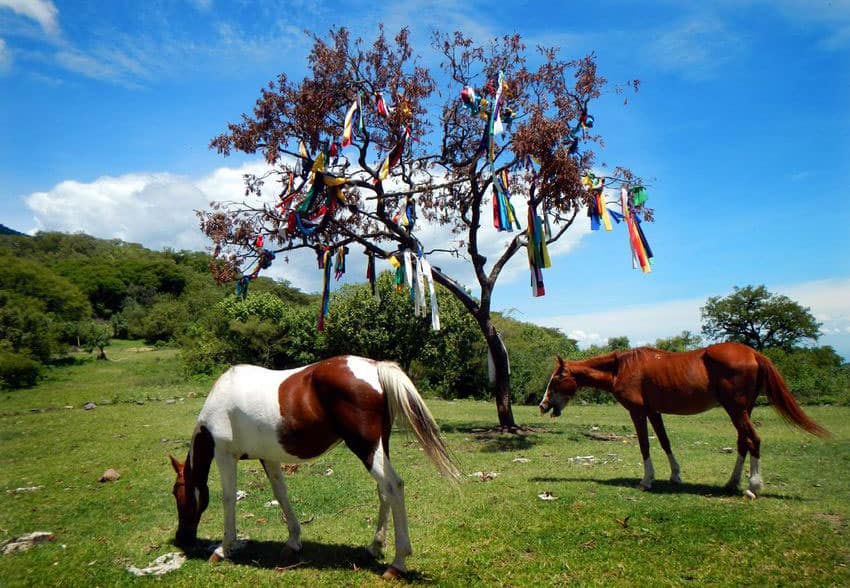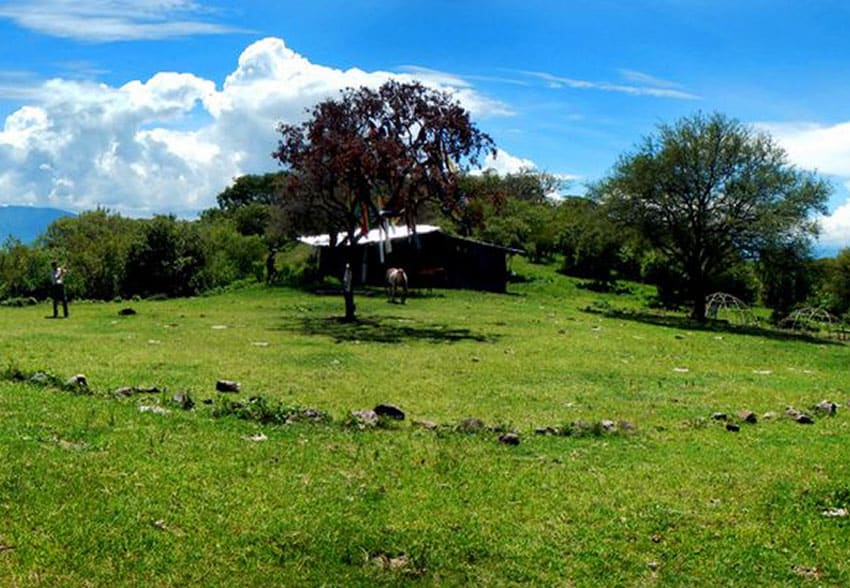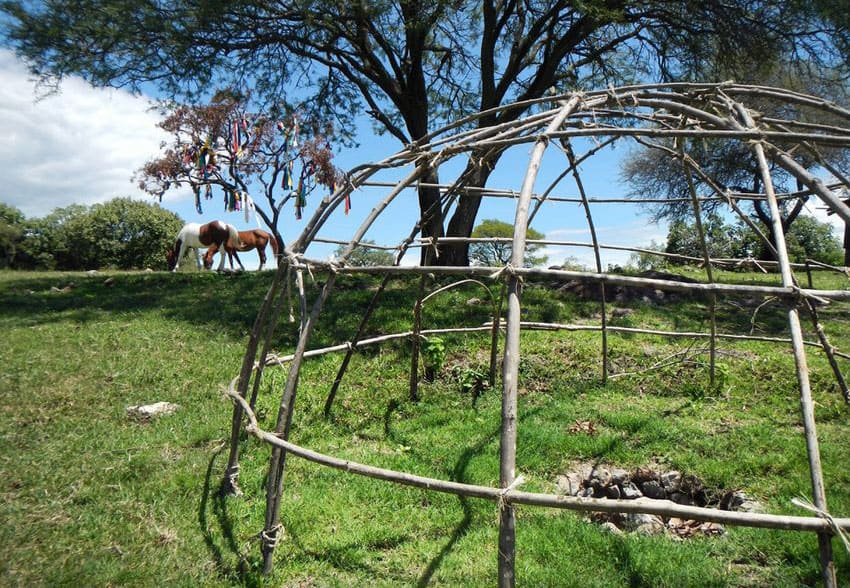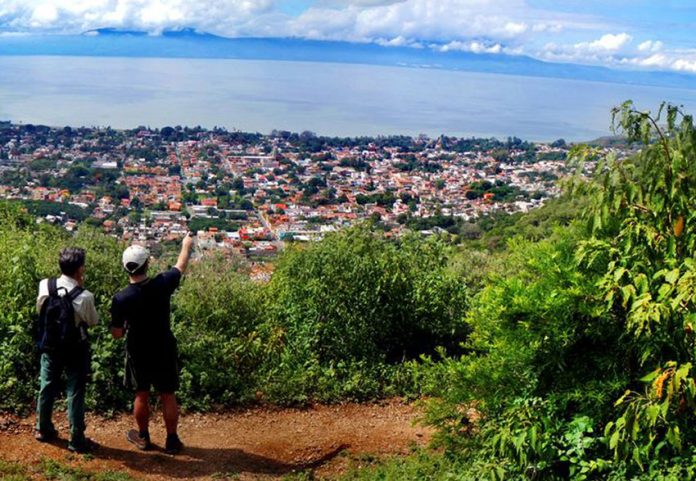One day I received an invitation to hike in the hills above the town of Ajijic on the north shore of Lake Chapala. My guide was to be long-distance walker and author Cam Honan, who goes by the name of “Swami” when he’s trekking.
“I want to show you a place everyone calls the Indian Ceremonial Grounds,” said Honan. “Every so often a large number of indigenous people gather together up there for something called La Danza del Sol. It’s a beautiful, wide open space with good vibrations and a magnificent view of Lake Chapala.”
As we started our hike, I couldn’t help but reflect on how lucky the people are who live along Chapala’s northern shore. They don’t have to drive 50 kilometers to the nearest mountain; all they have to do is walk out the door, stroll up the street and step onto any one of dozens of narrow trails.
It’s amazing. One minute you’re on a city street and suddenly you are engulfed by high walls of luxuriant green vegetation. You feel like you’re in some exotic jungle, thousands of miles from civilization.
Honan took me on a long, meandering route to several picturesque spots overlooking the lake (he is, after all, a long-distance walker) and it was only after a few hours that we found ourselves approaching the Ceremonial Grounds along a narrow trail beneath a canopy of creeping vines.

Then, suddenly, we stepped out onto a wide, flat, grassy meadow that took my breath away. In the middle of it there was a lone tree festooned with long red, white, blue, green and yellow strips of cloth. The tree was surrounded by a very large circle of stones and nearby, there were two buildings which, said my guide, serve for sheltering and feeding the many indigenous people who come here from far and wide.
Just outside the circle there were two igloo-shaped frameworks made of thin branches. With the help of blankets, these are transformed into temazcales, or sweat lodges.
“Back in 2002 or 2003,” said Honan, “I saw a ceremony performed here. A group of men, shirtless, attached cords to bones which were literally sewn inside part of their chest. The cords were attached to this tree and all the men walked around it. There was music playing in the background. Then the music stopped and they all pulled back simultaneously — and out came the bones.”
Well, that description certainly got my attention and, back at home, I started to search for information about La Danza del Sol. I learned that the piercing ceremony is ancient and that its purpose is to offer personal sacrifice as a prayer for the benefit of one’s family and community.
The ritual became well-known thanks to the 1970 movie A Man Called Horse with Richard Harris, which is said to be based on the real-life experience of the Spanish explorer Álvar Núñez Cabeza de Vaca.
Of course I made a point to get myself a copy of A Man Called Horse and was truly amazed that such a fine film could have come out of Hollywood in 1970, not to mention the fact that it’s a western in which the Sioux speak Sioux the whole time!

The story of how the very first Danza del Sol was held in Ajijic is described in a thesis written by Aldo Daniel Arias, who was allowed to be present at the campsite by volunteering to do work like cutting wood and carrying water.
Arias says the organizers decided to hold the event at the spot I visited, known as La Mesa de los Encinos. This was a picturesque place, it seems, but originally it consisted of two hills side by side, not exactly a suitable site for holding a dance.
So, all sorts of volunteers went to the place and “a punta, pala y carretilla” — with picks, shovels, wheelbarrows and much hard work — they lowered the high places and raised the low places and ended up with a wide, flat, Meseta de la Danza.
Finally, in 1991, the first Danza del Sol was held on this mesa. Many people showed up from all over Mexico and the United States, plus over 100 dancers. It seems that the Danza is traditionally held in July or August, when plant growth is at its maximum.
I understand that, according to Arias Yerena, the main purpose of the event is to thank the Great Spirit for the gift of life. Curiously, the Tree of Life, which is four to five meters high, is not growing inside the circle but, like a Christmas tree, is chopped down in the woods, carried to the site and made to stand up in the center of the ceremonial circle. Decorated with colorful strips of cloth, it stays there all year and is replaced before the next dance begins.
To be admitted as a dancer, candidates must have assisted the group for at least the previous two years and must present an offering of copal or tobacco. In the ceremonial area, they must refrain from certain practices such as yoga, politics and Catholic rituals and may not use alcohol, marijuana, peyote or other plants, except for sage and tobacco.

During four days and nights, the dancers fast from all food and drink. Every day, in the full glare of the summer sun, they dance and sing for seven rounds (sessions), each lasting from 45 minutes to an hour. The singing is in the Lakota language, which most of the participants don’t understand.
Unlike Muslims, who can eat and drink once the sun goes down, these dancers must aguantar (endure) without sustenance for the entire period and I can’t imagine how they could do it. It is said that many suffer spells of dizziness, headaches, stomach aches, kidney pains and sheer exhaustion.
Perhaps some relief is experienced during daily sessions in the temazcal, but I doubt it, because another test of a warrior is to endure extreme heat during this ceremony.
Arias’ description of the rituals which take place before, during and after this steam bath tally with those practiced all over Mexico and suggest to me that the sweat lodge is the one indigenous ceremony which really unifies all the native peoples of the American continent.
The Offering of Skin takes place on the last day. According to Arias, it is made by passing two wooden stakes through the chest of the (male) participant, stakes which are attached to two cords which are tied to the tree.
At the end of the ceremony, the dancer dances backward away from the tree and breaks the skin where the stakes are embedded. When this happens, he prays and gives thanks and then makes a circuit of the stone circle, saluting the four cardinal directions.
[soliloquy id="93716"]
Says Arias, “the offering of skin is an act through which the dancers sacrifice a part of themselves, that is, a piece of their own flesh. In this way, the dancer becomes the offering itself, an act which results in his unity with nature and the Great Spirit.
In case you are thinking of giving this ceremony a try (which, they say, Richard Harris did), note that Arias states, “. . . Among these offerings, the most valued are those which are carried out with the most enthusiasm and pain.”
If you’d be satisfied simply taking a hike to this extraordinary place, see the Danza del Sol trail on Wikiloc.
The writer has lived near Guadalajara, Jalisco, for more than 30 years and is the author of A Guide to West Mexico’s Guachimontones and Surrounding Area and co-author of Outdoors in Western Mexico. More of his writing can be found on his website.
